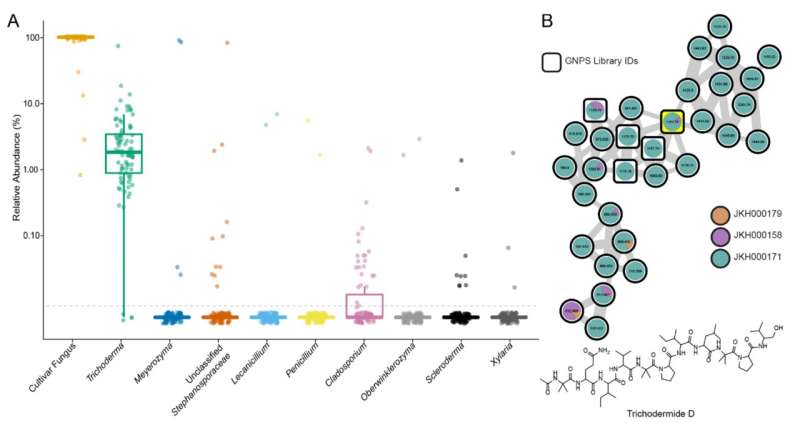
Welcome to Read Healthy Tips!

“Weed early and sometimes” is the important thing to a productive backyard. Apparently, sure species of ants are additionally avid gardeners, a observe they’ve refined over 50 million years. They too weed their underground fungus gardens, however how they know what to weed out has been a thriller. Now, a multidisciplinary staff of scientists report in PNAS on June 15 how ants distinguish the great fungus from the unhealthy.
Individuals depend on sight to establish weeds however ants develop fungus underground in the dead of night and should have different methods to sense undesirable backyard denizens. A staff led by Jonathan Klassen, Ph.D., on the College of Connecticut and Marcy Balunas, Ph.D., on the College of Michigan has discovered that the ants sniff out diseased fungus by detecting chemical compounds known as peptaibols.
The staff targeted on the ant species Trachymyrmex septentrionalis whose habitat follows the pine barren ecosystem from Lengthy Island all the way in which south to East Texas. Trachymyrmex ants develop their fungus under floor and feed it recent natural detritus. The fungus acts nearly like an exterior intestine for the ant colony; the fungus grows up and across the recent meals laid on prime of it in honeycomb shapes, produces digested meals for the ants because it grows, after which secretes waste.
Klassen Lab graduate scholar Katie Kyle, a co-first creator on the paper, experimentally contaminated ant nests with Trichoderma, a naturally occurring, disease-causing fungus that infects the ants’ gardens and located that the ants started working additional time to take away the an infection from the nests, rising their waste output.
Over the winter, whereas the ants have been dormant, the staff analyzed the fungal biomes of a number of completely different ant nests collected from completely different areas and located Trichoderma in all of them.
Co-first creator Sara Puckett, Ph.D., a latest graduate from the Balunas’ UConn lab, ready extracts of Trichoderma containing the natural compounds of the fungus to find out if the weeding was triggered by a number of of those compounds or just by the presence of the pathogen’s cells.
“We have been curious to see if the ants have been weeding due to compounds produced by the infecting fungus,” Balunas stated.
The staff discovered the Trichoderma extract, when utilized to the fungus backyard, despatched the ants into frenzied weeding exercise simply as precise Trichoderma infections had.
Working with scientists from College of California, San Diego and College of North Carolina, Greensboro, they found the nests contained peptaibols, a household of compounds identified to be produced by Trichoderma. Nonetheless, discovering which particular peptaibols have been inflicting ant weeding proved tougher since these extracts contained many compounds.
The researchers examined pure peptaibols, together with two new compounds known as trichokindins VIII and IX.
It seems that every one the peptaibols examined triggered some degree of ant weeding, a discovering that suggests it will not be one explicit peptaibol however slightly that the entire suite of peptaibols can induce the ants to weed their backyard.
“This suite of Trichoderma compounds inducing ant habits is in distinction to many different pure merchandise whose exercise can typically be attributed to 1 compound,” Balunas says.
Though their information assist peptaibols as a sign to weed, it is not clear what precisely the ants are perceiving. It might be that the invading Trichoderma fungus produces the peptaibols and the ants detect them after which weed, observe the researchers. Or maybe the ants are detecting a secondary response from the fungus backyard itself.
The subsequent step is to determine these particulars of ant-fungus communication, Klassen says.
“Perhaps the fungus is signaling ‘I am sick’. Perhaps the fungus is detecting the peptaibols. We have to flesh out the chain of signaling,” Klassen says.
The findings spotlight one of many few identified techniques the place an animal responds to a illness of its helpful symbiotic companion as an alternative of a illness of its personal physique, a phenomenon that Balunas and Klassen are calling an prolonged protection response, and one which they stay up for persevering with to tease aside.
Extra data:
Kathleen E. Kyle et al, Trachymyrmex septentrionalis ants promote fungus backyard hygiene utilizing Trichoderma -derived metabolite cues, Proceedings of the Nationwide Academy of Sciences (2023). DOI: 10.1073/pnas.2219373120
Offered by
College of Connecticut
Quotation:
Analysis hints at how fungus farming ants hold their gardens wholesome (2023, June 16)
retrieved 16 June 2023
from https://phys.org/information/2023-06-hints-fungus-farming-ants-gardens.html
This doc is topic to copyright. Other than any honest dealing for the aim of personal research or analysis, no
half could also be reproduced with out the written permission. The content material is offered for data functions solely.
Uncover the secrets and techniques to a more healthy way of life at Read Healthy Tips.
Our web site is a complete useful resource for invaluable data, suggestions, and recommendation on all features of well being. From common wellness tricks to recommendation on sustaining a wholesome way of life, our articles cowl a variety of matters associated to well being and well-being.
Go to our web site to discover and study extra about wholesome residing, improve your data of wellness, and make knowledgeable selections for a satisfying and satisfying life. Let’s go to our web site at Healthy Tips and begin prioritizing your well being in the present day!




